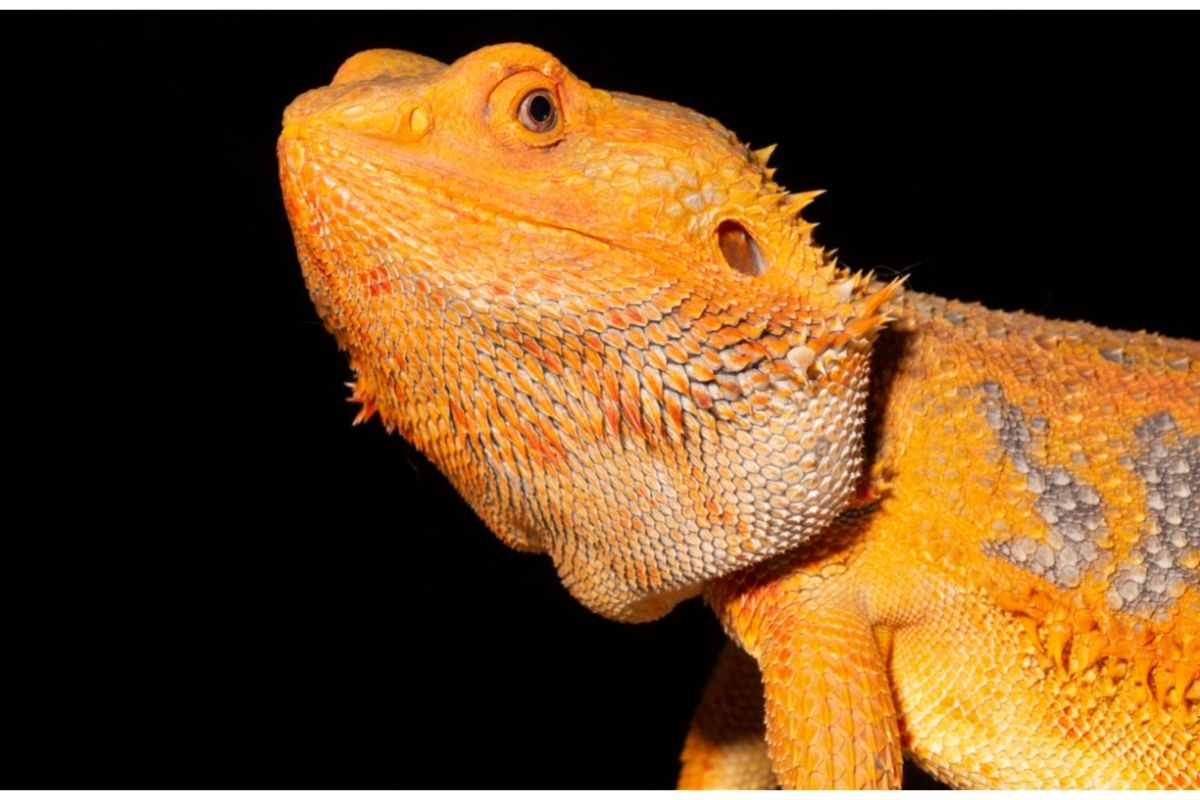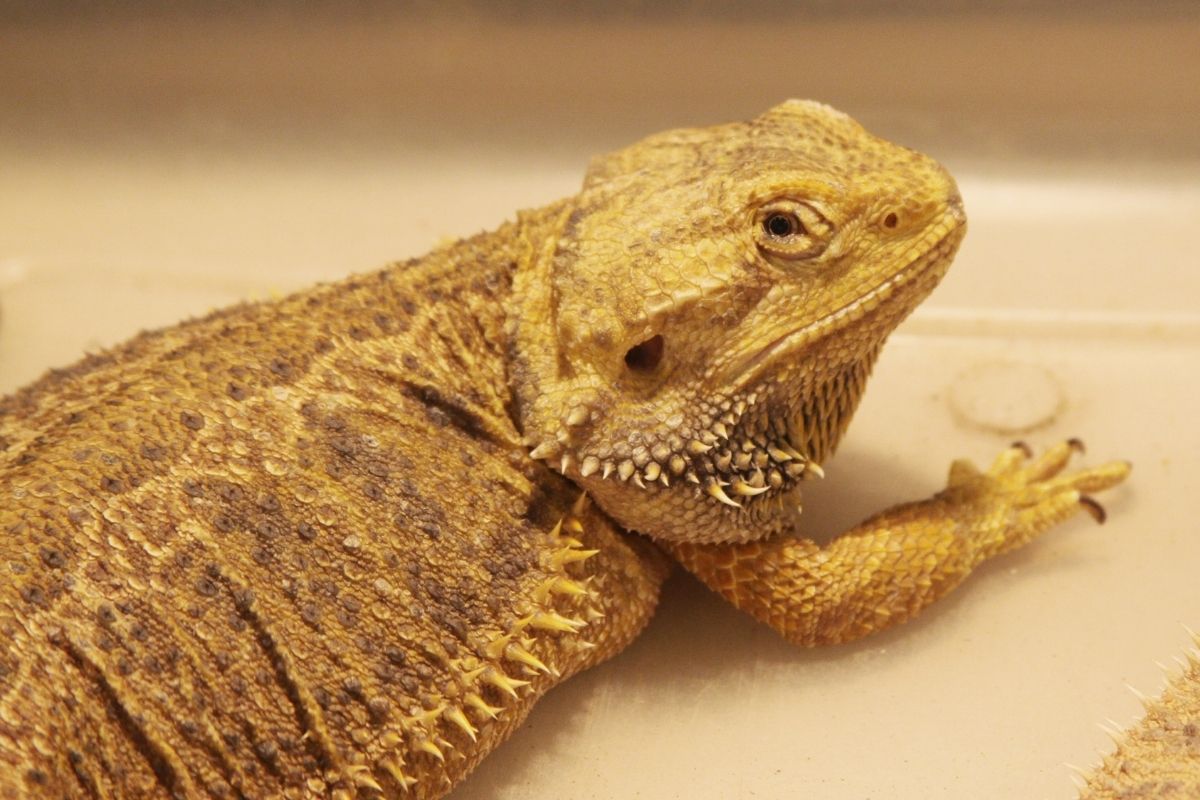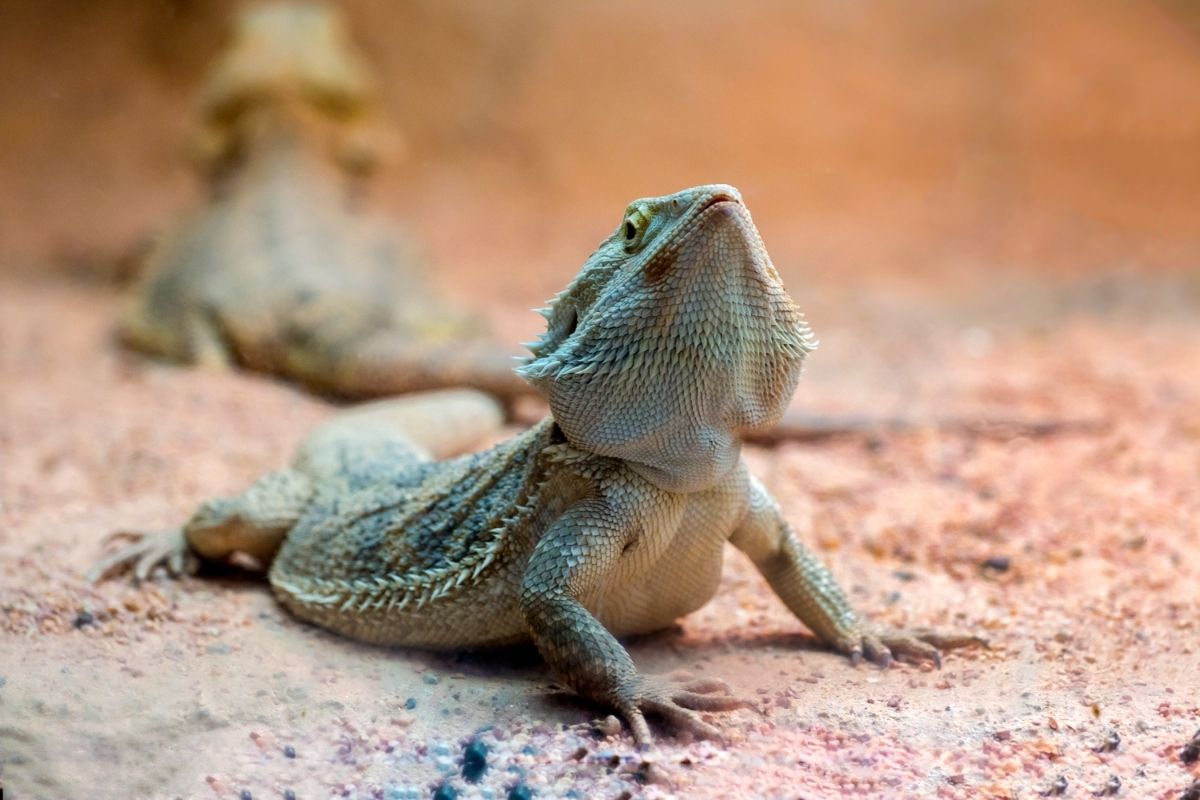Bearded dragons have a seemingly ironic name. Apart from their prehistoric appearance, these reptiles don’t share many similarities at all.
They’re not colossal, they don’t have an aggressive nature, and they don’t breathe fire.

The bearded part of their name, however, is somewhat true.
A little-known fact about bearded dragons is that they “puff up,” which is where their beard becomes enlarged, looking something like a lion’s mane.
Puffing up is a unique part of a bearded dragon, but what does it mean?
Here is our guide to the reasons why bearded dragons puff up!
What Is Puffing Up?
Puffing up is the term used to refer to when a bearded dragon “puffs up” its beard, which involves enlarging the skin and scales around its neck to create a mane-like shape.
This is where they get their name from.
Alongside the “puffing up,” their beard will often turn a darker shade of red, brown, or black.
This is often to appear more threatening to a predator, but there are a handful of other reasons why your bearded dragon might be exhibiting this behavior.
Why Do Bearded Dragons Puff Up?
They Feel Threatened
Bearded dragons aren’t exactly at the top of the food chain.
These reptiles aren’t big or particularly threatening, with only their small, pointed teeth and long claws providing any form of defense.
So, to make themselves seem larger and more of a threat than they actually are, they will puff up their beards when they feel threatened by a potential predator.
In the wild, predators of the bearded dragon include snakes, larger lizards (such as goannas), birds of prey, and marsupials.
As they are so regularly sought after as prey, they will use their puffed-up beard to not only seem larger than they actually are but also to confuse the predator into thinking they are poisonous to consume (which, of course, isn’t the case).
Bearded dragons won’t come into contact with such predators when kept as a pet, but that doesn’t mean they don’t carry those defensive instincts.
Anything can be mistaken for a predator for a captive bearded dragon, including another bearded dragon, a new object, or even a child’s toy on the floor.
To prevent your bearded dragon from feeling threatened in their vivarium, make sure to clutter the area with hiding spots such as caves and plants for them to easily hide underneath.
This will make them feel safer against potential threats, so they don’t have to resort to their puffing-up defense mechanism.
If you intend on keeping two bearded dragons in the same vivarium, we recommend making sure the vivarium is large enough to accommodate both of the dragons.
There should be enough space for separate hiding spots and basking areas to prevent any form of territorial behavior.
They’re Showing Off
While it might not sound believable to some, bearded dragons are surprisingly charismatic reptiles.
They might even be puffing up their beards in an attempt to show themselves off to you!
This often happens after a shed because it allows them to stretch into their new skin and encourages any stuck shed to loosen.
It also means they can show off their new, shiny scales.
They’re Looking For A Mate
In the same way that a bearded dragon might be puffing up to show itself off to you, they might also be doing it to attract a mate.
Male bearded dragons have a particularly large ego during the mating season, which is typical during spring and early summer, marking the end of the brumation period.
They will display interesting behaviors to make themselves appear dominant to a female, which includes puffing up their beards as large as possible.
When a female bearded dragon sees a puffed-up male, it’s the best form of communication for the male to exude his confidence to the submissive female.
Sometimes, the female will also puff up when attracting a male, but it’s mostly male dragons that exhibit this behavior.
This will make sense if you intend to breed your bearded dragon.
If your male (or female) beardie is puffing up without another dragon in the vivarium, they might have mistaken a toy or new object for a mate.
They’re Showing Their Happiness
Contrary to popular belief, when a bearded dragon puffs up, this doesn’t always mean they are being aggressive or feeling threatened.
Sometimes, in the same way, that they puff up their beards to impress someone, they might simply be showing their happiness!
As mentioned before, bearded dragons are charismatic and highly communicative reptiles that will often use their beards to express their joy.
So, if your beardie is otherwise acting normal (isn’t running to a hiding spot or hissing, for example), then it might simply be showing you that it is content and happy.
They’re Taking A Bath

Most times, you give your bearded dragon a bath. They probably won’t puff up their beards.
However, if your beardie starts to puff up its beard while you’re bathing it, this is actually a communication tool to tell you that the water is too deep.
Bearded dragons are terrestrial reptiles, meaning while they technically have the ability to swim, they prefer to stay on land.
Bathing your bearded dragon is an essential part of their care routine, as it keeps their scales free from bacteria and dirt and encourages a healthy shed.
However, if the water is too deep, they might puff up their beards as a flotation device.
Even if they don’t end up using their puffed-up beards to help them float, it means that they don’t feel necessarily safe in such deep water.
It makes sense when you think about it. Taking in more air provides more buoyancy in the water, which helps them to float.
Not only are bearded dragons not the best swimmers, but bathing them in deep water can actually cause water to travel into their lungs.
This is because bearded dragons aren’t very good at hydrating themselves through drinking water, so they rely on regular baths to hydrate their skin.
Too much water can actually fill up their lungs, causing secondary drowning.
Instead, you should only fill the bathtub or sink with an inch or two of water.
The general rule of thumb is to make sure the water doesn’t exceed the height of their rear knees.
This allows the beardie enough water to hydrate and get cleaned without fear of drowning.
They’re Preparing To Shed
Like most reptiles, bearded dragons will shed their skin.
The frequency of these sheds depends on the age and health of the dragon, but on average, a healthy adult would shed a few times a year.
One of the best ways for a bearded dragon to prepare for the shed is by puffing up their beards.
They will do this to encourage the skin around their head, neck, and chest to loosen.
Not only is this beneficial for the bearded dragon (as it encourages a healthy shed), but it also gives you an idea of when to prepare for the shed yourself.
If your beardie has adopted a cycle of puffing up its beard before going into the shed days or even a week later, this acts as a reliable timescale for the shed.
However, don’t worry if your bearded dragon doesn’t puff up its beard before every shed.
While this is normal behavior, it doesn’t happen all the time with every bearded dragon. It’s just something that some beardies like to do.
If the shed was unsuccessful or came off in separate parts, your bearded dragon might be puffing its beard to encourage the stuck shed to loosen.
You can help loosen stuck shed by ensuring their habitat is in the perfect requirements (including temperature and humidity), misting them, bathing them, and resisting the urge to pull off the shed yourself.
During / After Eating
The last reason why bearded dragons puff up their beards comes with little scientific evidence, but the theory isn’t too far-fetched.
Bearded dragons sometimes puff up their beards during and after eating, and there are two theories as to why.
The act of puffing up their beard is believed to allow more room to consume food.
In the same way that rodents fill their cheeks with food in the winter, it is believed that wild bearded dragons will puff up their beards to make space for more food.
This theory is supported by the fact that food is more scarce in the wild than in captivity, so once they see any form of food, they will do what they can to store it.
Even if they aren’t hungry, they can technically store food in their puffed-up beards until they can find someone to keep it away from predators.
If your bearded dragon does this while eating in their vivarium, this might be because they don’t know when to expect their next meal.
This is an instinctual response because beardies can go for some time without regularly eating in the wild, so they might just be preempting a period of limited meals.
If this happens, try to stick to a regular feeding schedule to reassure them that they will definitely receive another meal.
You can also try giving them a smaller meal next time to see if they stop puffing up. This way, they might feel less inclined to stuff themselves.
Another reason why a bearded dragon might puff up their beard during or after eating is to make them appear more intimidating when there are predators or bearded dragons nearby.
When food is scarce in the wild, bearded dragons might use this technique to keep their food to themselves.
This often happens when you live feed bearded dragons or if you have recently introduced a new bearded dragon to the vivarium.
Do Baby Bearded Dragons Puff Up?

Yes, it is possible for baby bearded dragons to puff up! This is for a number of reasons.
The main reason why baby bearded dragons might be puffing up their beards is that they are feeling unsettled in their new habitat.
This is a completely normal response when bringing a baby bearded dragon home, so don’t worry too much about it.
Likewise, if your baby bearded dragon doesn’t puff up when moved into its new habitat, this just means it feels comfortable already!
The best way to help the baby beardie feel more comfortable in their new habitat is to fill the vivarium with hiding spots, such as caves, plants, and decor.
This provides a comforting space for them to hide when they feel unsafe.
You should also make sure the tank requirements are ideal, including the size of the tank, the temperature, the substrate, and the humidity.
Another reason why a baby bearded dragon is puffing up is that they might feel nervous around you.
This doesn’t mean they are going to be aggressive – it just means they want to defend themselves in case you are a predator.
The only way to relieve them of this stress is to commit to regularly handling and bonding with your bearded dragon.
Eventually, they will come to associate your skin, scent, and sounds with safety and trust, meaning they won’t puff up around you anymore.
Is Puffing Up Bad For Bearded Dragons?
If you’re freaking out because you’ve witnessed your bearded dragon puffing up for the first time, don’t worry about it.
To put your mind at ease – puffing up is a totally healthy and natural response for a bearded dragon.
Puffing up isn’t bad for your bearded dragon, nor will it cause any health problems.
It’s just your dragon’s way of communicating with you that they feel threatened, needs to shed, is looking for a mate, or they’re just wanting to express their contentment.
The best thing you can do is to understand why your beardie might be puffing up and react to the situation accordingly.
Are the tank requirements ideal? Have you poured a bath that is too deep? Have they just left the brumation period?
Is there something new in the tank that seems threatening?
In Summary
So, there you have it! Hopefully, this guide has put your mind at ease when you see your bearded dragon puff up.
Puffing up is a totally normal and instinctual response to a bunch of situations, which is why it’s so important to understand why your beardie is puffing up.
Frequently Asked Questions
Why Does My Bearded Dragon Keep Gulping?
When a bearded dragon repeatedly gulps, this is because they are swallowing enough oxygen to “puff up.”
This is where their necks become inflated to produce a mane-like beard. There are multiple reasons why this is happening, including:
– They feel threatened
– They’re looking for a mate
– Their bath water is too deep
– They’re stocking up on food
– They want to impress another bearded dragon
– They’re showing their happiness
Gulping and puffing up is a healthy and normal communicative tool that beardies use.
Puffing up their neck makes the bearded dragon appear larger, which is why they mostly do this when they feel threatened.
Eventually, the beard will deflate, and your bearded dragon will be back to normal.
